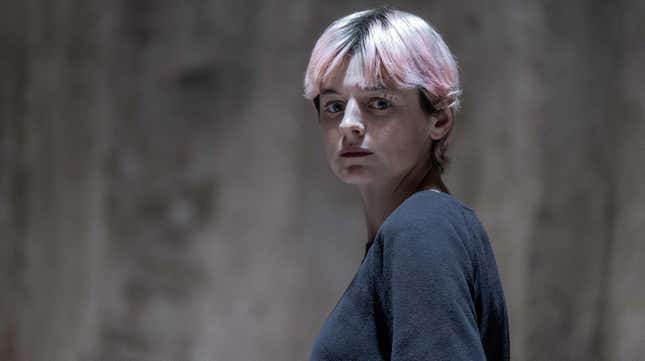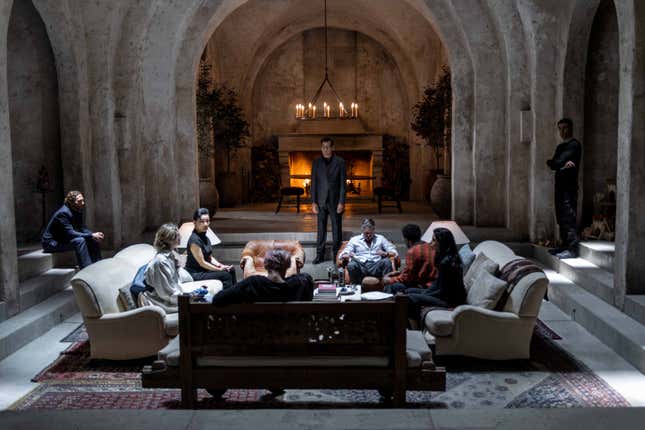
[Editor’s note: This recap, like all recaps on The A.V. Club, contains spoilers.]
The series finale of A Murder At The End Of The World opens with an elevator to hell. Fifty meters below the Earth, a destination chosen because Ray determined that that’s the distance needed to avoid any nuclear fallout, Andy explains as he gears up for his showstopping reveal. It’s just a shame that Andy hasn’t figured out everything quite yet.
Throughout its short run, AMATEOTW has struggled to balance the genre’s two narratives. Creators Marling and Batmanglij built competing arcs: one where Darby plays a retired detective brought back into the game after the death of her ex-boyfriend, Bill; the other tracks her first case, the Silver Doe Killer, and how her relationship with Bill ended. But the writers could never quite marry the road trip romance with its tech-based whodunit. The proportions always seemed a little off, showing us via flashback how Darby developed her deduction skills and how her obsession with killers scared Bill off. When the show spent more time filling us in on the Silver Doe, it detracted from the mystery that often strained to build forward motion. Whodunits always go backward and forward, with the past clarifying the present. Outside of showing us Darby’s strengths and weaknesses, the Silver Doe Killer mystery rarely did this, making these stretches a bit meandering, particularly in episodes that ballooned in runtime.
The creators intend this to be a more empathetic version of the whodunit, where the detective learns more about their feelings than their investigation skills. Heck, by having the B story focus entirely on how the investigator got their powers, they’re upending a vital component of the drama. How often do we see Poirot or Columbo in flashbacks? These characters are often many steps removed from the crime they’re investigating. Here, it’s all Darby and a little Bill, regulating all the backstory about the suspects and their relationship to the crime in exposition. Call it faulty programming because these elements dragged in those overlong episodes, treading the same ground as they stumbled over its over-plotted trail. None of it was awful, but with this cast, this budget, and this many good ideas, a better show was in there somewhere. Maybe it’s more of a failure of editing than faulty programming.
When the show focused, that promise could blossom as if it were soaking in the sun’s rays bouncing around 160 feet of tunnels and mirrors. These last two episodes, particularly this finale, gave us a glimpse at what this show always should’ve been: a snappy, melodramatic mystery tempered with cabin fever-induced dread. “Retreat” made good on the show’s promises as Corrin and Owen, in a booming, mustache-twirling performance, bring this drawing room mystery of a finale to a close. That the ending was surprising, logical, and a bit silly was the icing on the cake.
Now, the ending doesn’t have to be satisfying for a whodunit to work (right, Murder On The Orient Express?), but it certainly helps. Also helping: Clive Owen takes charge of the story’s mask-off moment when answers come to the fore. Rather than giving this to Darby at first, Andy goes through each member of his retreat, barking accusations at them and giving into that rage we saw last week. Owen brings the heat as Andy, a man no longer able to hide his abusive, controlling, and woefully shortsighted interior. With the cops finally on the way, Andy decides to hold the retreat hostage in his little Zoomer tomb. Andy spent millions creating a bomb shelter that could protect Zoomer from any possible catastrophe, except meeting his biological father. That’s the one thing that Andy could not predict. But we’ll get to that.
First, Andy has a few things to get off his chest. For instance, whoever guessed that David attacked Darby in her room, come on down and collect your prize. David threw on a thick pair of black leather gloves, grabbed the nearest hunting knife, and attempted to scare Darby off the case. We’ve got to give it up to David, a pro at knife-wielding threats. Has he done this before? We’ll never know because that reveal is overshadowed by what Andy says about Lee: He deleted her criminal record, presumably using the “clean slate” from The Dark Knight Rises. The explanation helps clear up any lingering questions about Lee’s loyalty to Andy. She was more or less using him, which makes more sense than genuinely liking the guy. After all, when we first heard about Lee in the premiere, she seemed more like an anti-establishment Hacktivist in the mold of Trinity, who famously “cracked the I.R.S. database” in her pre-Matrix days. How she ended up with the personification of tech dickhead can only be explained through some transactional relationship.
Lee has a criminal past, too, just not one that anyone would blame her for. As a 14-year-old, Lee did the old Superman III/Office Space routine, shaving thousands of small increments off massive financial transactions. Lee breezes through this stuff kind of quickly (maybe it would’ve been helpful to learn about Lee’s past in the Scientologist enclave in Clearwater, Florida), but her parents went into debt, her father went to jail, and she started hacking.

Owen builds tension in this scene, squeezing Lee out of the frame and wielding his power before her and the retreat. He slowly recaps his accusations at Lee, who he believes was planning to take his son and ruin his reputation, company, and life’s work. That’s when Zoomer’s remote ambulance enters, and Zoomer announces that he made pancakes with extra chocolate chips for Lee. Sometimes, the moppet lays it on a little too thick. As Andy grabs Zoomer and his aids attempt to take the child from the room, Darby gets hung up on Zoomer’s insistence that he must finish his game. She puts on the helmet and sees the creepy vision playing before Zoomer’s eyes. Ray is guiding Zoomer upstairs to finish their game, and the sight is so shocking that Darby rips the helmet off and asks Zoomer about Bill. While Darby’s response to seeing Ray didn’t totally click with us, Corrin’s gentle interrogation of Zoomer pulled the show together rather slickly. Through her soft-spoken prodding, Darby draws out the truth: Under the guise of a game, Ray had Zoomer murder Bill and Rohan. However, Sian was an unexpected casualty of Ray’s safeguards against hacks, causing her helmet to malfunction.
Ray and Zoomer as the killer was an inspired twist. The show seemed to treat its AI reverently for so long, pushing Ray to the background. Over the last few episodes, Ray hasn’t been featured as prominently. He becomes a tool for collecting information, providing medical advice, and a shoulder to cry on, but the show was wise to keep him in the realm of a benevolent, mindless virtual assistant. Having him lead Zoomer to kill is a genuinely creepy idea, an original take on AI that presents a new bent on the Child’s Play dynamic. There have been many murderous toys whose actions are blamed on the owner. That’s not the case here because the show doesn’t linger on Zoomer’s responsibility and instead treats him like the victim of manipulation.
With the cards on the table, Darby uses Oliver’s deepfake app to hack into Ray’s therapy files. She knows what it’s like to turn to Ray for comfort, and so does Andy. Hidden within his memory banks is a recording from the first night of the retreat, with Andy fuming with jealousy, telling his robot therapist that Bill was a threat to the future of Andy’s company. Andy worries, logically or not, that if Bill were to challenge Andy for Zoomer’s guardianship, Bill could end up owning the company. Ray reads this as a direct threat to the company, one of his prime directives, so it concocted a game where Zoomer would inject Bill with morphine and kill him.
As the police enter the hotel, Darby, Lee, and Zoomer break for the server farm, showing the child what Ray actually is. The sight of all those computer systems whirring away does put in perspective the amount of energy required to animate an AI that can trick a child into murder. It certainly can’t be helpful for the whole climate catastrophe Andy’s preparing for. That thing’s got to go. So finally, after all this time, Lee and Darby get to work together, hacking the old-fashioned way: setting a laptop on fire and hurdling it into the servers.
Now, about those Bill scenes. I found them much more successful here than in other places, but I don’t think they work in the end. Do they inform the story at all? The B-plot helps reveal a bit about Darby, but what did we learn from Bill if the show’s message is to find answers through the victim? That Darby should remember the good times? That it’s okay to say goodbye? Did Zoomer know he had a connection to Bill that was more powerful than anything Andy had (a weird message about adoption, but the show does frame the biological father as the one who truly connects with Zoomer)? It’s all a bit messy as Murder At The End Of The World has been, getting the mustard of sincerity all over its snow-white shirt.
The show ends with another split narrative. Darby reads her book to the room of supportive new friends as she imagines Lee and Zoomer making a break toward freedom. The idea that Darby can move on is a satisfactory ending to the show, especially when we think about where she’s been. Darby’s reading of the book shows her growth as much as she’s no longer dying her hair pink. She learns that it isn’t about the killer or the victim: It’s the “terrifying culture that keeps producing them.” In the end, Darby is writing Bill’s story so he doesn’t disappear, nameless and faceless, into the night. People will remember his name: Bill Farrah.
These last moments reveal that by allowing herself to embrace and share their relationship, Darby has found space for herself and her memories. The Silver Doe ends with an anti-climax as discovering the killer leads to a greater understanding of the crime. Retreat pays tribute to those who were lost, the victims, whose lives can be remembered appropriately rather than another casualty of patriarchal violence. The show ends on a hopeful note, with Lee and Zoomer firing a flare and waiting for rescue. They may be at the end of the world, but their lives are just beginning.
Stray observations
- “What are you doing for love now, Lee? Because David tells me you’re planning another great heist…OF. MY. SON!”
- It’s good to know that, even with the whole tricking a child to murder thing, Mei Lu is still interested in bringing Ray to her smart city.
- Darby’s reading epilogue was a nice moment of bookend to the series, but I have to wonder: Is her book being read as non-fiction? Do readers around the world know that Andy’s kid killed two people?
- Look at Marius, standing up for himself
- What did Chekov say about deepfake apps? If you introduce one in episode one, it must be used in episode seven.
- I loved the Zoomer as killer stuff, but his injecting Bill was a bit much. It worked better in my mind than on camera.
- “We built safeguards against this” is such a funny thing to say in response to the particular situation where you’re AI coerces your son into killing his biological father.
- I don’t know if I can forgive a show that had Joan Chen and did nothing with her.